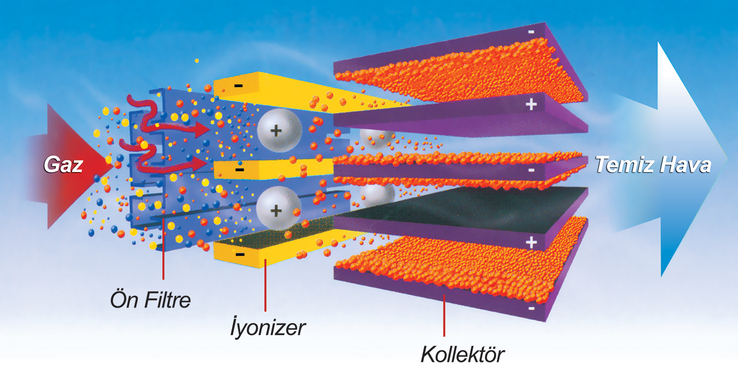
How to Filter Flue Gases?
Smoke is an air pollutant that can be released from many different sources, both in industrial activities and in daily life. Smoke contains particles, oil vapors, gases and other pollutants. Smoke from sources such as barbecues, heating systems, vehicle exhausts and industrial facilities not only pollutes the environment, but also poses a threat to human health. For this reason, proper filtration of smoke is of great importance both in protecting the environment and preventing health problems. Several different technologies can be used to filter flue gases, and the effectiveness of this filtering process varies depending on the filtering system used, the content of the smoke and the operating conditions.
Flue gases are air mixtures that occur as a result of the combustion of various fuels. These gases mostly contain carbon dioxide (CO2), carbon monoxide (CO), nitrogen oxides (NOx), sulfur dioxide (SO2), particulate matter (PM), oil vapors, organic compounds and other polluting gases. The composition of flue gases varies depending on the type of fuel used, combustion efficiency and process conditions. These gases need to be effectively filtered because they contain substances that can have harmful effects on human health.
There are several main technologies used to effectively remove pollutants from flue gases. These technologies are designed to address different types of pollutants. These include electrostatic filtration, oil and particle filtration, gas filtration and carbon absorption technologies.
Electrostatic Filtration Systems
Electrostatic filters are one of the most widely used technologies for capturing particulate matter and fine dust from flue gases. In this system, particles in the flue gas are charged with an electrical charge and captured by a series of electrodes. The electric field polarizes the charged particles and these particles are directed to collection areas.
Electrostatic filters are particularly effective in capturing fine dust and particles. This system is also capable of capturing substances such as oil vapors and carbon. However, it should be noted that these systems do not directly filter gas components such as carbon dioxide and carbon monoxide.
2. Activated Carbon Filtering Systems
Activated carbon is a substance that can absorb many chemical components. Organic components in flue gases, VOCs (volatile organic compounds), ammonia, sulfur dioxide, etc. can be removed using activated carbon filters. Activated carbon filters are extremely effective in the process of adsorbing such gases and pollutants.
Activated carbon filtration is used especially in the removal of odor, harmful gases, and chemical compounds. These filters are used for the effective absorption of organic components and harmful gases.
Scrubber Systems
Scrubber systems, called scrubber systems, clean flue gases by bringing them into contact with liquid. In these systems, flue gases are mixed with a liquid solvent, usually water, and pollutants are dissolved. Scrubber systems are generally used in the removal of acidic gases such as SO2, HCl, NOx, etc.
The choice of technology to be used for filtering flue gases depends on many factors. These factors vary according to the components of the gas, particle sizes, process temperatures, environmental regulations and the needs of the facility. In industrial facilities, kitchens, heating systems or vehicles, the most suitable system should be selected by considering the advantages and disadvantages of each filtration technology.
Ozone Systems
Ozone offers an effective solution for cleaning flue gases and reducing environmental damage. Ozone, which has a high oxidation capacity, oxidizes polluting components such as sulfur dioxide, nitrogen oxides, carbon monoxide, and organic compounds and renders them harmless. This process is of great importance in preventing environmental pollution and improving air quality. The effect of ozone on flue gases in this way provides significant benefits for both the environment and human health.
A Selection for Industrial Facilities
Since flue gases in industrial facilities usually contain large volumes of gases and toxic chemicals, electrostatic filters and scrubber systems are generally preferred. These systems can effectively filter particles and gases and minimize environmental damage.
Choice for Kitchens and Restaurants
Smoke, oil and particles emitted from restaurants and kitchens usually contain oil vapors. For this reason, electrostatic filtration systems and active carbon filter systems are frequently used in kitchen environments. These systems clean the air while also helping to eliminate bad odors.
Filtering flue gases is of great importance in terms of environmental protection and human health. Particulate matter found in flue gases different technologies such as electrostatic filters, oil and particle filtration, ozone, active carbon filtration and scrubber can be used to effectively remove sulfur, gases and chemical compounds. The filtration system to be selected depends on the application area, the composition of the gas and the needs of the facility. Therefore, the most suitable solution should be determined by considering the advantages and limitations of each system.
İlker KURAN
Alperen Mühendislik Ltd. Şti.







